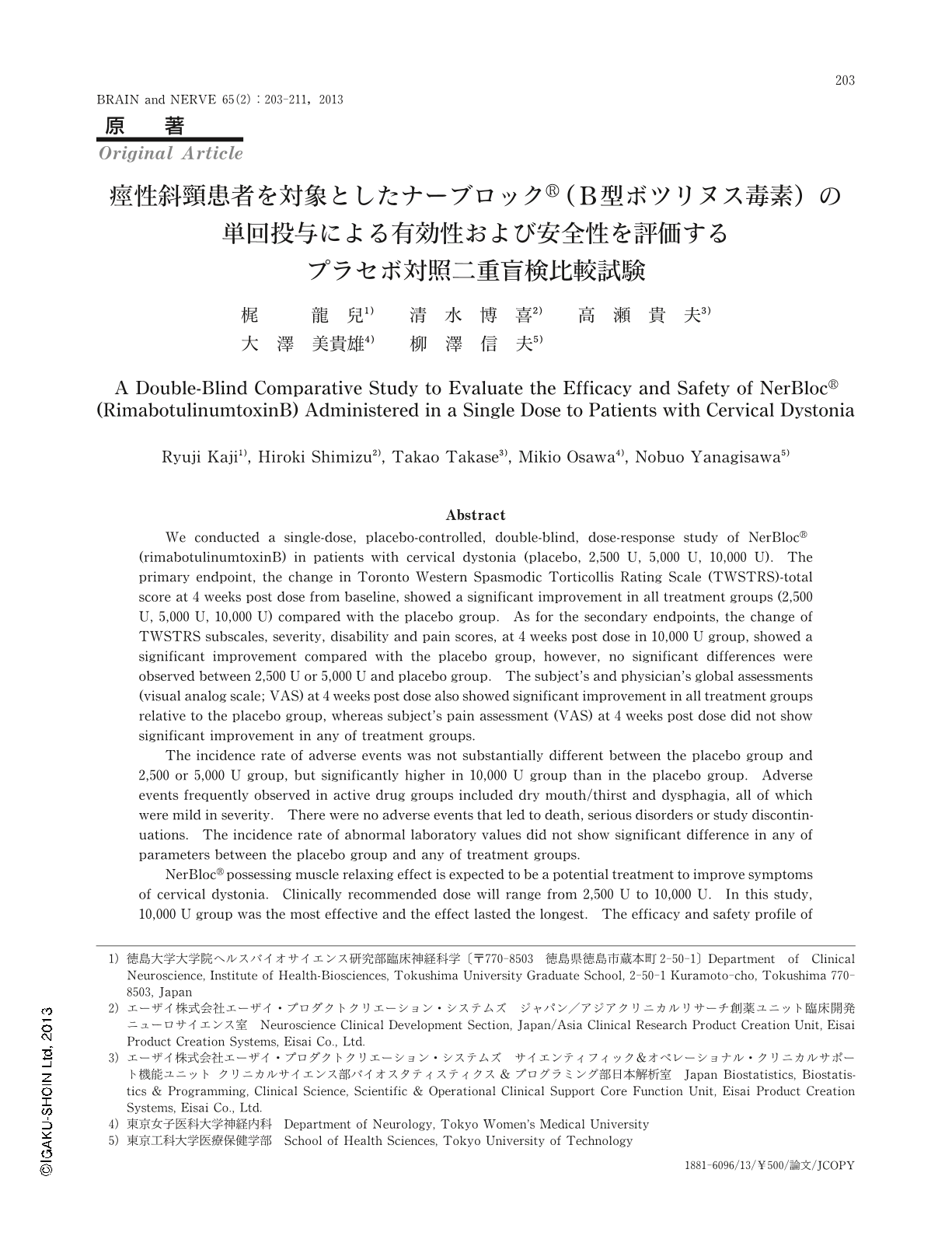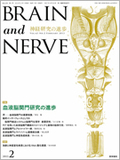Japanese
English
- 有料閲覧
- Abstract 文献概要
- 1ページ目 Look Inside
- 参考文献 Reference
はじめに
ナーブロック®(米国:MYOBLOC®,欧州:NeuroBloc®)は,米国Elan社(現在はUS WorldMeds社に移譲)で開発されたB型ボツリヌス毒素製剤であり,痙性斜頸治療薬として欧米はじめ世界18カ国以上で使用されている。
痙性斜頸(頸部ジストニア)は,頸部筋の異常収縮により頭位偏倚をきたす局所性ジストニアの一型である。主な症状は,頭位偏倚および振戦であり,脊柱側彎もしばしばみられ,頸部痛の合併が多くみられる。発症は突発的であり,外傷,精神的ショック,過度の労作などが誘因と考えられている。従来,治療には抗コリン薬や筋弛緩薬などの薬物療法,外科的手術などが試みられてきたが,必ずしも十分な治療方法ではない。
ボツリヌス毒素は,嫌気性細菌であるClostridium botulinumにより産生される蛋白質毒素であり,その抗原性によりA~G型の7型に分類される。毒素型により受容体および作用する蛋白質が異なるが,ボツリヌス毒素の基本的な作用は末梢のコリン作動性神経終末からのアセチルコリン放出を抑制することであり,これにより神経筋伝達を阻害し,筋の麻痺をきたす。
この毒素の作用を応用した臨床研究は古くから行われており,1960年代に米国の眼科医A. Scottは極少量のボツリヌス毒素を局所に筋注し,神経伝達阻害作用による限局性の筋緊張亢進の緩和を目的とした臨床研究を行った1)。1980年代後半には,米国を中心に痙性斜頸に対するA型ボツリヌス毒素の臨床試験が開始され,ボツリヌス治療が従来の治療法に比較して有効性が高く,安全な治療であることが示された。B型ボツリヌス毒素についてもA型ボツリヌス毒素と同様に痙性斜頸に対する治療薬として開発され,外国ではElan社が1993年から痙性斜頸を対象に臨床試験を開始した。その後,米国,欧州でそれぞれ2000年12月,2001年1月に同適応で承認された。
今回,日本人の痙性斜頸患者におけるB型ボツリヌス毒素の有効性および安全性を検証するために,プラセボを対照とした多施設共同無作為化二重盲検並行群間比較試験を実施した。主要評価には痙性斜頸の評価尺度であるToronto Western Spasmodic Torticollis Rating Scale(TWSTRS)*1を用いた。本稿では本試験の結果を報告する。
Abstract
We conducted a single-dose, placebo-controlled, double-blind, dose-response study of NerBloc®(rimabotulinumtoxinB) in patients with cervical dystonia (placebo, 2,500 U, 5,000 U, 10,000 U). The primary endpoint, the change in Toronto Western Spasmodic Torticollis Rating Scale (TWSTRS)-total score at 4 weeks post dose from baseline, showed a significant improvement in all treatment groups (2,500 U, 5,000 U, 10,000 U) compared with the placebo group. As for the secondary endpoints, the change of TWSTRS subscales, severity, disability and pain scores, at 4 weeks post dose in 10,000 U group, showed a significant improvement compared with the placebo group, however, no significant differences were observed between 2,500 U or 5,000 U and placebo group. The subject's and physician's global assessments (visual analog scale; VAS) at 4 weeks post dose also showed significant improvement in all treatment groups relative to the placebo group, whereas subject's pain assessment (VAS) at 4 weeks post dose did not show significant improvement in any of treatment groups.
The incidence rate of adverse events was not substantially different between the placebo group and 2,500 or 5,000 U group, but significantly higher in 10,000 U group than in the placebo group. Adverse events frequently observed in active drug groups included dry mouth/thirst and dysphagia, all of which were mild in severity. There were no adverse events that led to death, serious disorders or study discontinuations. The incidence rate of abnormal laboratory values did not show significant difference in any of parameters between the placebo group and any of treatment groups.
NerBloc®possessing muscle relaxing effect is expected to be a potential treatment to improve symptoms of cervical dystonia. Clinically recommended dose will range from 2,500 U to 10,000 U. In this study, 10,000 U group was the most effective and the effect lasted the longest. The efficacy and safety profile of NerBloc®in this study was similar to that in AN072-009 study conducted in the US.
(Received: April 27, 2012, Accepted: August 1, 2012)

Copyright © 2013, Igaku-Shoin Ltd. All rights reserved.


